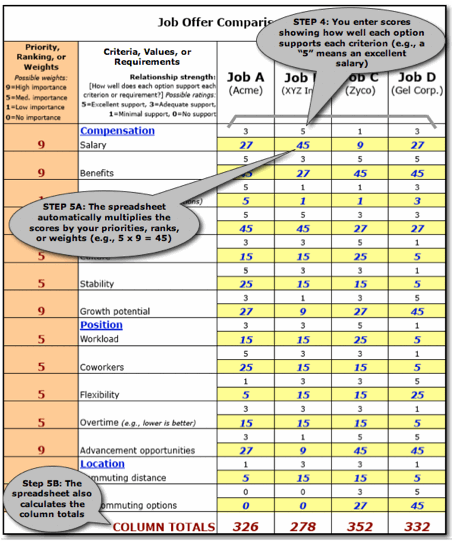Use This Handy Tool to Make Really Tough Decisions
by Adele Sommers
Decisions, decisions, decisions! How do we ever manage to make them? If you think about how haphazardly or emotionally we resolve to do things at times, it’s somewhat surprising when we actually succeed.
You may have noted that decision-makers often feel pressured to arrive at expedient outcomes when working on critical issues under short deadlines. Sidestepping sound decision-making techniques can occur “for the sake of the schedule.”
And you also may have seen that rushing through a crucial decision-making process can easily backfire. It can actually cause a project to go over budget and end much later than the original schedule would have dictated.
Is this familiar? Have you ever struggled to pinpoint the best solution to a problem, decide among business ventures or product alternatives, choose between two or more schools or job offers, select the best candidate to hire, or figure out where to go on holiday? I’m sure you’ve encountered situations in which you would have welcomed extra help with making decisions.

The best decisions for complex problems can withstand future challenges because they use structured techniques. These techniques help the participants generate breakthrough ideas, jointly analyze risk, and weigh alternatives. Intricate decisions made without them can quickly fall apart and may even cause harm.
That’s why I’m going to share with you a stellar decision-making technique I’ve used for years. Clients have told me it’s changed their lives! It can help you stop arguing with yourself or others about the decisions that you or your organization might be agonizing over today. What is your peace of mind worth?
 The “Swiss Army Knife” of Thinking Tools The “Swiss Army Knife” of Thinking Tools
In contrast to some of the chaotic scenes described above, imagine being able to make difficult choices relatively quickly, reliably, and realistically.
The tool I’m about to describe works equally well for personal issues, team problem solving, engineering, or strategic planning — primarily when several solutions or alternatives could apply. When used in a group setting, it has insightful, consensus-building effects.
Often referred to as a “prioritization matrix” or “weighted scoring method,” it goes by several different names and has numerous variations. And it boasts about as many uses as a Swiss army knife.
I’ll tell you right up front that there’s some arithmetic involved. But you certainly don’t need to be a math whiz to master it. You can easily use this method with a calculator or by plugging the basic formulas into a spreadsheet.
Ready to Try the Prioritization Matrix?
Okay, let’s get started.
When using this technique, you’ll be identifying values, requirements, or criteria that matter most to you with regard to the decision to be made. How does it work?
 For example, let’s imagine that you’ve received multiple job offers. You realize that each position has pros and cons related to the salary, benefits, location, and more. This will make your selection more challenging than it might initially appear. For example, let’s imagine that you’ve received multiple job offers. You realize that each position has pros and cons related to the salary, benefits, location, and more. This will make your selection more challenging than it might initially appear.
So, let’s take the example of choosing among job offers to illustrate the use of the prioritization matrix.
Note that the annotated images below show how each step appears in a specially formatted spreadsheet containing the formulas described in the process.
Step 1: To begin the job-selection process, you would start by thinking about which aspects of any job matter most to you. As you identify those areas, consider how your job-related wants and needs probably fall into general categories, such as compensation, company, position, and location.
Within the broader categories like compensation, you could expect to have more detailed criteria, values, or requirements, such as salary, benefits, and perks. Below are just a few of many possible categories and their associated criteria:
- Compensation (salary, benefits, perks)
- Company (reputation, culture, stability, growth potential)
- Position (workload, coworkers, flexibility, overtime, advancement potential)
- Location (commuting distance, telecommuting options)
Note that the categories and criteria themselves are fairly neutral. That’s because only you (or you and your team) can decide the importance of each with regard to whatever you’re comparing.
Proceed to list all of the categories and their criteria, values, or requirements in the middle column of the spreadsheet.
Step 2: In the far-left column, assign each of the criteria you listed a measure of importance by giving it a priority, ranking, or weight. The purpose is to increase or decrease the impact of each criterion in the formula depending on how much it matters to you. Numbers work well for this purpose:
- Larger numbers indicate more importance or a higher rank or priority.
- Smaller numbers indicate less importance or a lower rank or priority.
Note that you could use any number range you wish (ideally, the wider the better) to accentuate the differences in your values, such as:
- High importance = 9
- Medium importance = 5
- Low importance = 1
- No importance = 0
Step 3: Next, list the job options (or vacation spots, business ventures, or whatever you’re comparing) in the right-hand columns across the top. At this point, the job offer comparison spreadsheet might look something like this, before we begin scoring the options:

Step 4: To score the job offers, decide how well each option listed across the top supports each criterion, value, or requirement listed in the middle column. This is what’s called “relationship strength.”
Scoring these relationships involves another set of multipliers. Once again, you could use any number range you wish for the multipliers in these ratings, such as:
- Excellent support = 5
- Acceptable support = 3
- Minimal support = 1
- No support = 0
For example, if salary is one of your criteria, how well does Job B support it? If Job B has an attractive salary, you might enter a “5” as the score for Job B, as illustrated in the image below.
Ultimately, you would rate the salaries and all of the other criteria on your list for each of the job offers.
Step 5A: Multiply each score you entered in Step 4 by the corresponding priority, ranking, or weight in the far-left column. (The spreadsheet formulas will calculate this for you automatically.)
For example, if you scored the Job B salary as a “5” (“excellent”), and salary has a weight of “9” (“high importance”) in the corresponding far-left column, the resulting total for the Job B salary would be 45 (5 x 9), as shown below.
Once you’ve entered your scores in the spaces provided in each column, you (or your spreadsheet) can multiply each score by its corresponding weighted value to fill in all of the empty cells.
Step 5B: Finally, sum all of the scores in each Job Offer column (the spreadsheet will do this for you automatically).
The example below displays the grand totals at the bottom:

What Were the Results?
As shown above, you can finally see how your options compare with one another based on your criteria. The highest-total-scoring options represent your best choices. Notice that in this job-offer example:
- Job B had the highest salary score, but the lowest grand total, and
- Job C had the lowest salary score, yet the highest grand total!
This interesting phenomenon could occur whenever you allow all of your values to have a “voice” in the process. In this case, it meant there were several other considerations that, taken together, were as or more important than salary. It shows that making any complex decision too superficially by basing it on only one attractive criterion might turn out to be a bad idea!
A Few Additional Tips…
 This process essentially translates your values into a scoring tool. The final results may reinforce your gut-level feelings about heading in a certain direction, or could surprise you with new insights or an unexpected outcome. If something seems really off-kilter, however, try a “calibration process” of adjusting the weights or ratings until they more accurately reflect the kinds of results that seem reasonable to you and your team. This process essentially translates your values into a scoring tool. The final results may reinforce your gut-level feelings about heading in a certain direction, or could surprise you with new insights or an unexpected outcome. If something seems really off-kilter, however, try a “calibration process” of adjusting the weights or ratings until they more accurately reflect the kinds of results that seem reasonable to you and your team.
- The goal is not to aim for pinpoint accuracy using this type of scoring system. Rather, you’re striving to accentuate or even exaggerate the contrasts among the options, to better reveal how different they are and identify those most aligned with your values.
In conclusion, this technique has served its purpose if you feel at peace with your final decision. Since we often base decisions on incomplete information, however, it always helps to have a fallback plan just in case circumstances change or a selection doesn’t work out as hoped. In that case, consider pursuing the next-highest-scoring alternatives, since you’ve already weighed their merits as part of this exercise.
(If you’d like to try the above spreadsheet template, you can download it here.)
Copyright 2022 Adele Sommers
|


